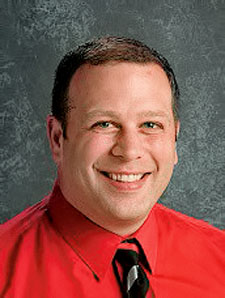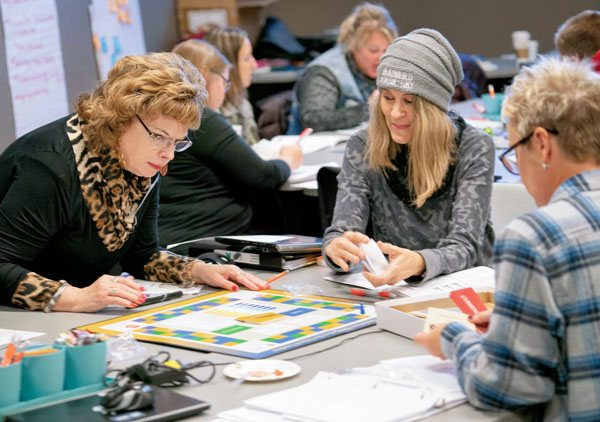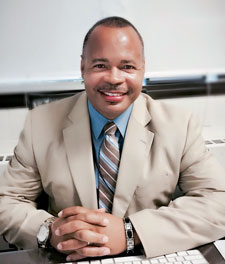Damian Patnode couldn’t believe his good fortune when he was hired as assistant principal at Milaca High School, enrollment 800. He grew up in this east-central Minnesota town and, after a few years away for military service, had returned as a teacher. During five years in classroom teaching, he’d also earned his master’s degree and principal’s licensure.
A month into his new job, doubts loomed.

“I thought ‘What have I done?’” he remembers. “I would go to board meetings and just sit and listen. This is not to fault the training I went through to become an administrator. It’s just really tough to put all the things together.”
Patnode went on to become Milaca’s high school principal. But when he heard about a principal executive development program at the U—the Minnesota Principals Academy—he paid attention. In 2013, with the support of his superintendent and staff, he and elementary principal Steve Voshell became part of the next academy cohort.
For a total of 30 days spread over nearly two years, the two Milaca principals carpooled to classes that met two days a month in St. Paul, plus several days during the summers. With peers from urban, suburban, and rural schools, they covered units on instructional cores, alignment with standards, teacher evaluations, culture and equity, assessment and using data—all with leaders in the field and experienced professionals. Each chose a topic for an action learning project that would affect their school building to complete by program’s end. Driving back and forth, Patnode and Voshell continued the discussion and learning.
“It is the best professional development I’ve done as a principal,” says Patnode. “There are lots of reasons for that, and one is the format. It’s you and 30 other people, building relationships over two years and learning together. All the units are connected, and over time you see how everything fits together. You have day-to-day stuff, but you have the 30,000-foot stuff, too. The impact I’m beginning to see now.”
Close to half of Milaca’s students qualify for free or reduced lunch, and its special education population is nearly 20 percent—well above the state average of 13 percent. Patnode focused first on core instruction and then on aligning systems and standards.
“We’ve had two years of growth in student achievement across the board,” Patnode reports. “A lot of that is because I’ve been able to take what I’ve learned in this program and put it into practice.”
“It’s not how to be a good manager but how to be a good leader,” he says. “It starts with the vision, and then how you get there.”
As academy alumni, Patnode and Voshell were recruited as facilitators for units in the next Minnesota Principals Academy cohort, which met in Thief River Falls in 2015–17.
For the 2017–19 program—with cohorts in Brainerd/Staples, Fergus Falls, and the Twin Cities—Patnode has facilitated the unit on strategic thinking, where his experience and perspectives from three years in the army are valuable, as well as a unit on the math and science instructional core.
The academy’s goal is “to create a statewide network of district and charter school leaders who are motivated and have the skills to create and sustain schools in which all students are on the path to college readiness by the end of high school.”
Patnode has become a vital part of that network.

Bipartisan support and partnership
The Minnesota Principals Academy began with a bill in the Minnesota Legislature to create a program, inspired by the Bush Fellowships, for principals. Then-senator Steve Kelley was a driving force behind the bill. As chair of the Senate education committee, he visited schools across the state.
“One of the things I observed was, when you walk into schools and meet the principals, you can tell the schools that have good leadership,” remembers Kelley, now commissioner of the Minnesota Department of Commerce. “I realized the importance of the principal for the success of schools, and that it would be a really cost-effective strategy to invest in the leadership skills of the principal.”
The bill passed, providing an appropriation to the Minnesota Department of Education (MDE). A request for proposals went out, and education commissioner Alice Seagren selected the University of Minnesota to implement it.
The academy was created through a collaboration of MDE, the U, Minnesota Elementary School Principals Association, Minnesota Association of Secondary School Principals, and Minnesota Business Partnership. They used the National Institute for School Leadership (NISL) as a starting point. Half the participants’ costs came from their districts and half from the legislature, with the director’s salary paid by the U.
“It was a natural match for us,” says Jim Bartholomew, education policy director for the Minnesota Business Partnership. “For our members to succeed, and for our quality of life, we need a well-educated workforce and citizens. We looked at the research and we’ve done studies, and what’s abundantly clear is the role of the school leader in assembling the team and establishing a culture.”
Since it began in 2006, the Minnesota Principals Academy has trained 15 cohorts. Based in CEHD since 2013, the academy brings a nationally renowned curriculum, tailored to Minnesota’s needs, facilitated by Minnesota educators, to communities across the state.
The academy is founded on overwhelming evidence that there are no great schools without highly effective principals, and that strong communities depend on strong schools.
As the academy describes it, principals set the vision, guide instruction, build budgets, unite their teams, and lead the drive for results.
“That person, like Principal Patnode, becomes a key to moving expectations to a higher level,” says Rep. Sondra Erickson (R-Princeton), a sponsor of the bill to renew the academy’s funding this year. Fifteen years ago, she was a classroom teacher when Seagren called her to look into the proposed program, and she has followed its progress. Says Erickson, “The academy is strong in teaching principals the skills—choosing curriculum, using data, formal and informal assessment—and moving them into leadership.”
Thirteen years in, the Minnesota Principals Academy is a success. Alumni of the program praise its effectiveness, and schools bear them out.
Laine Larson has sent not only her principals but her whole administrative team—twice—once as superintendent in Thief River Falls and again when she became superintendent in Brainerd. She attended, too.
“I deeply appreciate and passionately support the professional learning provided by the Minnesota Principals Academy,” says Larson. “What it has done for our team is to bring principals and district administration together to continually improve and support instructional leadership at the building and district levels. This learning has improved our ability to strategically plan and address the needs of each individual learner. To me, the most beautiful part of this professional development is our ability to reflect, discuss, and develop our district as a system. We are one united team moving our students forward.”
Credibility and collegiality
At the helm of the Minnesota Principals Academy since 2013 is Katie Pekel, principal in residence in CEHD, an energetic no-nonsense educator with years of success as a principal herself in Austin, Minnesota. Participants praise Pekel for her own skilled leadership, which includes building strong cohorts and demanding the best from participants.
“Katie’s credibility has a lot to do with the program’s success,” says Staci Allmaras in the Fergus Falls cohort. “She’s just brutally honest, and everything is based on how people learn.”
At the U, Pekel is on a mission to challenge and prepare principals across the state to become agents for empowering their schools, students, and whole communities.

“The academy made me look at myself as a leader, stretch myself as a leader, and become an instructional leader,” says Duane Dutrieuille, principal of Hazel Park Academy preK–8 school in St. Paul, part of the 2015–17 cohort. “It has helped me to reach all our key stakeholders and communicate effectively, cross-culturally and across segments. It has changed my practice, having confidence and knowing good teaching.”
School will be out for summer soon. For 110 Minnesota principals, June also will mark the end of a learning journey that began nearly two years ago. In 2017 they set out to become better leaders. Now they are those leaders, joining a network that stretches from Austin to Thief River Falls.
“I’m just a phone call away from getting feedback,” says Dutrieuille. “Just this week a colleague from outside the metro called me about a student. The collegiality is the crux of it. This is not a Twin Cities leadership program—it’s good for the state of Minnesota.”
Building on success
Kim Gibbons met Katie Pekel shortly after Gibbons joined CEHD’s Center for Applied Research and Educational Improvement (CAREI) in 2015. Gibbons brought experience and success leading the St. Croix Regional Education District in east central Minnesota. At CAREI she began working to build the capacity of Minnesota’s 336 school districts. A priority was helping them make better use of research-based methods and data.
When her path crossed with Pekel’s, the two immediately recognized each other’s deep knowledge of schools and districts.
“We clicked,” says Gibbons. “We’d meet and talk because we had a lot in common, both coming from work in schools and now providing statewide services.”

Pekel reported that principals in the academy, energized by their learning, sometimes had trouble translating that learning back in their district offices. About the same time, Gibbons heard from a contact in western Minnesota.
Jeremy Kovash at Lakes Country Service Cooperative in Fergus Falls asked if there might be something like the principals academy for other district personnel—superintendents, curriculum directors, transportation directors, and directors of teaching and learning.
Gibbons, Pekel, and Kovash worked fast. They came up with a scope and sequence and an organizational context for something new—a one-year pilot program in tandem with the Minnesota Principals Academy cohorts in Fergus Falls and Brainerd/Staples. Three organizations pitched in $20,000 each—Lakes Country Service Cooperative, Sourcewell in Staples, and the Minnesota Association of School Administrators—to write the curriculum, deliver the program, and provide coaching.
The District Leadership Academy’s one-year cohort includes 30 administrators from nine districts. It’s added a new level of activity and energy to the principals academy meeting sites and communities, with career-changing results, according to Kovash. One example is learning to speak the same language around analytics; another is mental health.
“This forces us to look at causation and solving systemic issues,” says Kovash.
Superintendent Tim Lutz of Bemidji is part of the DLA along with seven members of his district’s team: curriculum and assessment coordinator, Indian education coordinator, director of special education, high school principal, two elementary principals, and director of Bemidji’s alternative schools and innovative career academies. That’s a big commitment, but he says the time was right.
Lutz came to Bemidji last year after 10 successful years in a much smaller school district. With 5,230 students, Bemidji is a district with a poverty level around 50 percent and trouble in a number of areas, from test results and graduation rates to engagement and discipline.
“The academy has really helped us build our team capacity,” says Lutz. “We’ve been able to work through the steps involved, to establish a sense of urgency, and to communicate a vision that can transform what we’re doing in a positive way.”
The drive time together is valuable, too, even in winter weather.
“A big part of the collaboration is that one-and-a-half hours to Staples or two-and-a-half hours to Fergus Falls,” he says. “We’re really focused, either gearing up or processing what we’ve just been learning. … Overall, it’s exciting and rewarding.”
Now Gibbons is working with Pekel to gain longer-term funding to be able to continue the District Leadership Academy.
“Even a couple of years ago, I did not in a million years imagine I’d be working with superintendents and districts like this,” says Gibbons. “It’s a highlight of my career.”
Read more about the Minnesota Principals Academy.
Read more about the Center for Applied Research and Educational Improvement (CAREI), home of the District Leadership Academy.
Story by Gayla Marty | Spring/summer 2019
